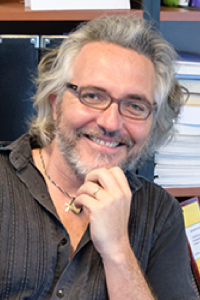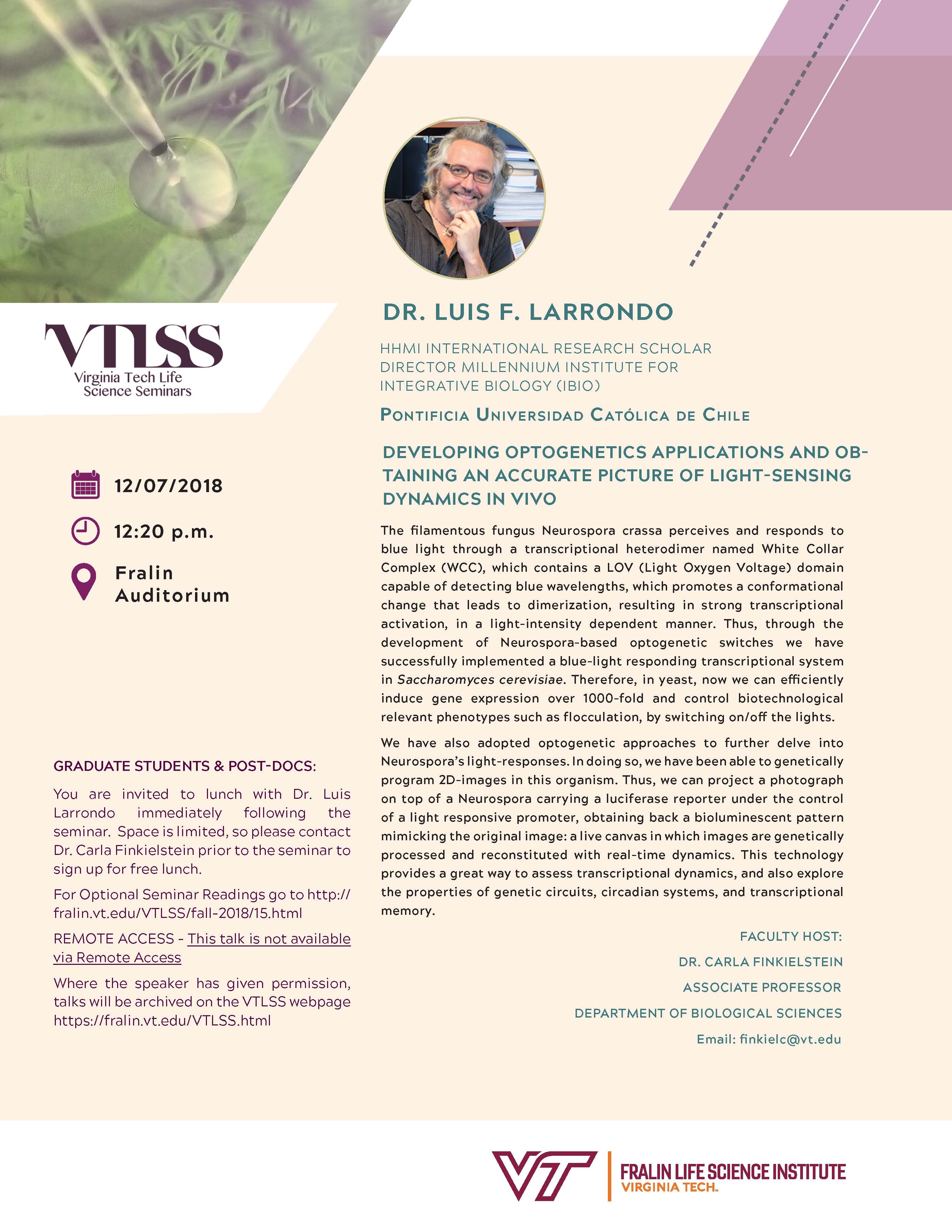Developing Optogenetics Applications and Obtaining an Accurate Picture of Light-sensing Dynamics in Vivo

Dr. Luis Larrondo; Pontificial University of Chile
December 7 at 12:20pm in the Fralin Auditorium, Fralin Hall room 102
Hosted by Carla Finkelstein
Luis Larrondo obtained his Ph.D. in cellular and molecular biology from the Universidad Católica de Chile. As a Pew Latin American fellow he conducted postdoctoral research at Dartmouth Medical School focusing on fungal functional genomics and circadian clocks. In 2009, he returned to his home institution in Chile where he is now an associate professor and director of the Millennium Institute for Integrative Biology (iBIO). Currently, his lab works with different fungal systems studying the molecular mechanisms underlying biological oscillators, and assessing the impact that circadian clocks have on physiology and in host-pathogen interactions. Through optogenetics and synthetic biology-based approaches his lab is also exploring the design of new oscillatory circuits, and synthetic circuits, capable of starting and sustaining circadian rhythms. Since 2017 he is also a HHMI International Research Scholar.
The filamentous fungus Neurospora crassa perceives and responds to blue light through a transcriptional heterodimer named White Collar Complex (WCC), which contains a LOV (Light Oxygen Voltage) domain capable of detecting blue wavelengths, which promotes a conformational change that leads to dimerization, resulting in strong transcriptional activation, in a light-intensity dependent manner. Thus, through the development of Neurospora-based optogenetic switches we have successfully implemented a blue-light responding transcriptional system in Saccharomyces cerevisiae. Therefore, in yeast, now we can efficiently induce gene expression over 1000-fold and control biotechnological relevant phenotypes such as flocculation, by switching on/off the lights.
We have also adopted optogenetic approaches to further delve into Neurospora’s light-responses. In doing so, we have been able to genetically program 2D-images in this organism. Thus, we can project a photograph on top of a Neurospora carrying a luciferase reporter under the control of a light responsive promoter, obtaining back a bioluminescent pattern mimicking the original image: a live canvas in which images are genetically processed and reconstituted with real-time dynamics. This technology provides a great way to assess transcriptional dynamics, and also explore the properties of genetic circuits, circadian systems, and transcriptional memory. iBIO, FONDECYT 1171151 and HHMI International Research Scholar grant.Flightless birds present an enigma: we know that birds evolved from feathered dinosaurs and are one of only two groups of vertebrates that can sustain powered flight, so why, more importantly, how did some birds lose this unique capacity? In this talk I will review the evolution of birds from dinosaur ancestors and discuss several groups of birds that have lost the ability to fly. I will then reveal new data on one group of flightless birds, the ratites - which include well known species such as ostriches, emu, kiwis and rheas – and show how our recent genomics work is providing unprecedented detail on the molecular details illustrating how these birds lost the ability to fly. I show that, rather than changing the sequence of specific genes that might cause skeletal changes leading to flight, ratites seem to have changed the sequence of noncoding regulators of important developmental genes. This result suggest that gene regulation, rather than changes in gene sequence, are more important in morphological transformations such as loss of flight.
Salinas F, Rojas V, Delgado V, López J, Agosin E, Larrondo LF. MBio. 2018;9(4). pii: e00626-18.
Circadian rhythms. Decoupling circadian clock protein turnover from circadian period determination. Larrondo LF, Olivares-Yañez C, Baker CL, Loros JJ, Dunlap JC. Science. 2015 Jan 30;347(6221)

This seminar will NOT be livestreamed or recorded.


